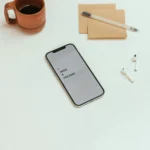In today’s digital age, smartphones have become indispensable tools for communication, entertainment, and productivity. But for many of us, they’ve also become a source of distraction, stress, and, at times, even addiction. If you feel like your phone is taking over your life—whether it’s the constant checking of social media, mindless scrolling through apps, or feeling anxious without it—you’re not alone. Smartphone addiction is a real issue, but the good news is, with some intentional strategies, you can take back control of your time and well-being.
Here’s how you can begin to overcome smartphone addiction:
1. Acknowledge the Problem and Identify Triggers
The first step in overcoming any form of addiction is acknowledging that it exists. Are you checking your phone as soon as you wake up, or do you feel a sense of panic if you can’t find it? Do you spend hours on social media or mindlessly browse apps with no clear purpose? Being aware of your habits is essential.
Once you’ve acknowledged the problem, pinpoint your triggers. Is it boredom, anxiety, or the need to stay connected? Understanding what prompts you to reach for your phone can help you address the root cause and develop healthier alternatives.
2. Set Clear Boundaries and Limits
One of the most effective ways to break free from smartphone addiction is to set clear boundaries for yourself. This could include:
- Designating phone-free times: Set specific hours during the day where you put your phone away—during meals, an hour before bed, or when spending time with family or friends.
- Using “Do Not Disturb” or Focus Mode: Many smartphones offer settings that allow you to mute notifications or temporarily block distracting apps during designated periods.
- Creating phone-free zones: Make certain areas of your home (like the bedroom or dining room) smartphone-free zones to encourage healthier habits and foster real-life connections.
3. Track and Limit Screen Time
If you’re not already aware of how much time you spend on your phone, it’s time to start tracking it. Many smartphones come with built-in screen time tracking features (like Screen Time on iOS or Digital Wellbeing on Android), which show you exactly how much time you’re spending on various apps and activities.
After tracking your usage, set daily time limits for specific apps or categories. For instance, you might decide that you’ll spend no more than 30 minutes a day on social media or limit your overall screen time to 2 hours. By being mindful of your usage, you create an opportunity to make conscious decisions about how and when to use your phone.
4. Turn Off Non-Essential Notifications
Notifications are designed to grab your attention and keep you hooked. Constant alerts from social media, messaging apps, and emails create an environment of constant distraction. By turning off non-essential notifications, you regain control over when and how you engage with your phone.
You can start by disabling notifications for apps that are not urgent, such as news outlets, games, or shopping apps. Reserve notifications only for essential communication—like calls or text messages—and check your email or social media at designated times.
5. Curate Your Digital Environment
Take a closer look at the apps you have on your phone and ask yourself: Are they serving you or distracting you? Decluttering your phone by removing apps that you don’t need or use frequently can reduce temptation and help you refocus.
For social media apps, consider unfollowing accounts that don’t add value to your life. Follow accounts that inspire you, promote positivity, and align with your goals or interests. The more you curate your digital environment, the less likely you are to get sucked into mindless scrolling.
6. Practice Digital Detoxes
A “digital detox” involves taking intentional breaks from technology to recharge your mind and body. This doesn’t mean you need to give up your smartphone entirely, but setting aside designated tech-free days or weekends can help you rediscover activities that don’t involve screens.
Consider going on a “social media cleanse” for a week or spending an entire day without your phone. Use this time to read a book, go for a walk, or engage in hobbies you enjoy. By consciously stepping away from your phone, you’ll realize that there is life beyond the screen.
7. Develop Healthy Alternatives
If you reach for your phone out of habit or boredom, try replacing that action with something more fulfilling. Instead of checking Instagram while waiting in line, carry a book with you or use the time to practice mindfulness or deep breathing exercises. Finding alternative activities that engage your mind or body will reduce the urge to check your phone reflexively.
Physical activity is another great way to break the cycle of smartphone addiction. Go for a run, take a yoga class, or simply take a walk. Exercise not only helps you stay physically healthy but also improves your mental well-being by releasing endorphins—your natural stress relievers.
8. Foster Real-Life Connections
One of the main reasons we stay glued to our phones is to feel connected to others. But often, these virtual connections leave us feeling more isolated and less satisfied than real-life interactions. Invest in relationships by spending quality time with friends, family, or loved ones without the distraction of phones.
Try setting up “phone-free” social gatherings where everyone agrees to put their devices away for the duration of the event. You’ll likely find that the conversations are more meaningful, and you’re more present with those around you.
9. Be Patient with Yourself
Breaking free from smartphone addiction is not an overnight process. It takes time, effort, and self-compassion. Don’t be too hard on yourself if you slip up. Celebrate small victories, like going an hour without checking your phone or spending a weekend without social media. Over time, these small wins add up and help you form healthier habits.
Final Thoughts
Smartphone addiction is a challenge in today’s fast-paced, always-connected world, but it’s one that can be overcome with intention and self-discipline. By acknowledging the issue, setting boundaries, and creating healthier habits, you can reclaim your time and mental clarity. Remember, the goal isn’t to completely eliminate your phone from your life but to use it in a way that supports your well-being and goals, not detracts from them.
So take a deep breath, step away from the screen, and start building the life you deserve—one where you’re in control, not your smartphone.
Click Here For Download Free Memes



